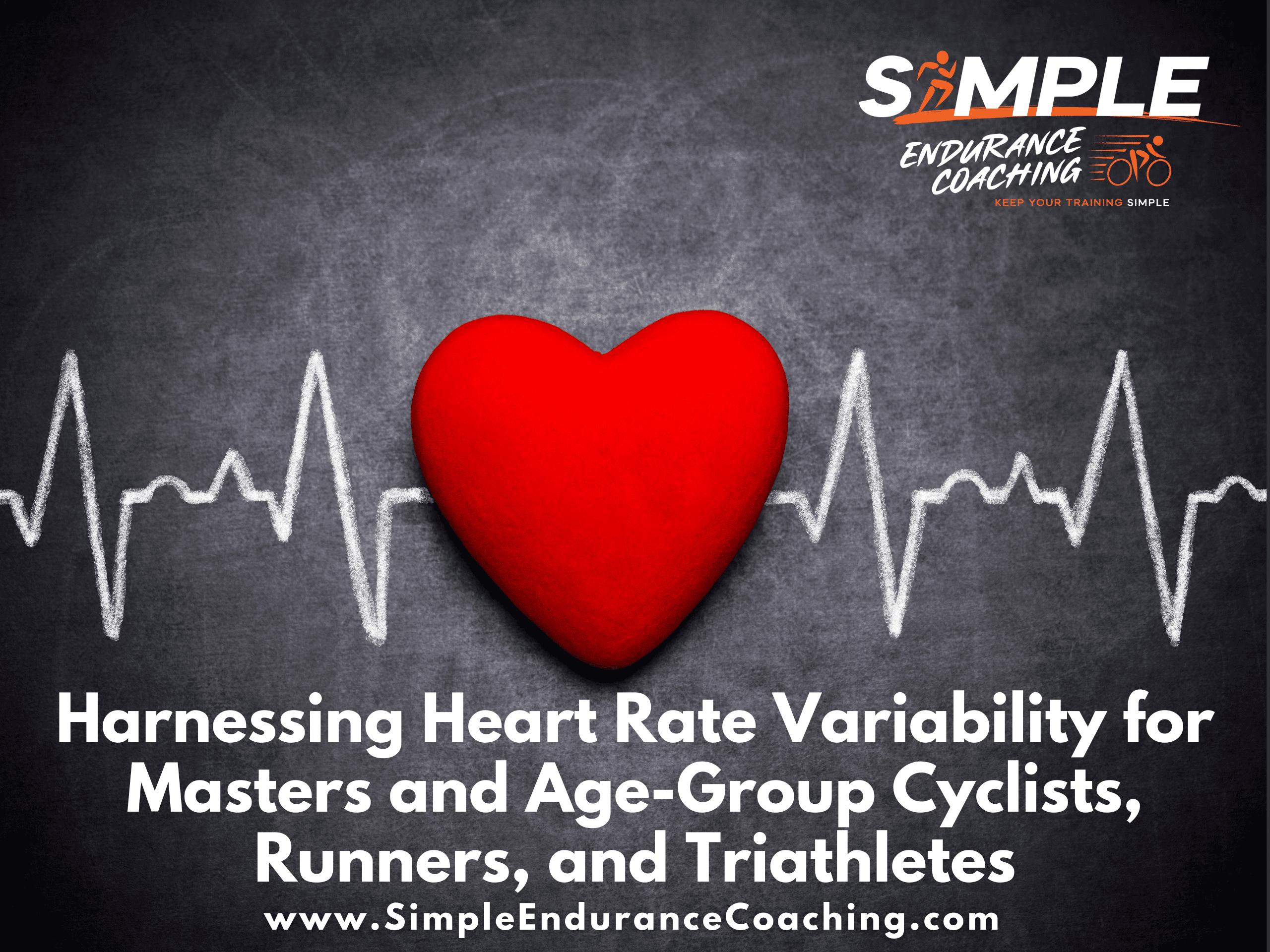Harnessing Heart Rate Variability for Masters and Age-Group Cyclists, Runners, and Triathletes
As an endurance sports coach, I work to balance training stress and recovery for my athletes.
Whether you’re a cyclist, runner, or triathlete, one tool I use for its ability to enhance training and recovery is Heart Rate Variability (HRV).
By understanding and monitoring HRV, older endurance athletes can gain valuable insights into their body’s response to training and make informed decisions to optimize their performance, especially recovery.
HRV is particularly effective since it provides valuable insights into the autonomic (involuntary) nervous system and overall recovery status.

What is Heart Rate Variability (HRV)?
Heart Rate Variability (HRV) refers to the variation in the time interval between consecutive heartbeats.
Unlike a steady metronome, a healthy heart does not beat at a constant rate.
Instead, the time between beats fluctuates in response to various physiological and environmental factors.
HRV is influenced by the autonomic nervous system, which regulates critical bodily functions such as heart rate, digestion, and respiratory rate.
HRV is particularly useful because it measures all of your stress, not just the training stress.
So if your work or family life is stressful, your HRV might be lower.
And that’s good to know before you pile on an additional load of training stress.
Why is HRV Important for Endurance Athletes?
- Training Optimization: By monitoring HRV, athletes can tailor their training programs to better align with their body’s current state. High HRV typically indicates a well-recovered and adaptable body, suggesting it might be a good day for intense training. Conversely, low HRV can signal fatigue or overtraining, suggesting a need for rest or lighter activities.
- Recovery Insights: HRV provides a window into an athlete’s recovery status. By tracking HRV, athletes can ensure they are adequately recovered before engaging in strenuous workouts.
- Stress Management: Endurance athletes often face significant physical and mental stress. HRV monitoring helps in assessing the overall stress load on the body.
- Injury Prevention: Overtraining and insufficient recovery are leading causes of injuries in endurance sports. Monitoring HRV can help identify early signs of overtraining.
How to Monitor HRV
Modern technology has made HRV monitoring accessible through various fitness-tracking devices and apps.
Popular devices like the Whoop Strap, Oura Ring, and Garmin watches offer HRV tracking as part of their feature set.
I recommend that my athletes use HRV4Training since research suggests it’s more accurate than other tools.
These tools collect HRV data, often during sleep, and provide insights through user-friendly interfaces.
The challenge is that HRV measurements can vary in accuracy depending on how they’re collected.
That’s one reason it’s important to compare your numbers on a single device and use the HRV readings as a tool, not the final decision.
Sometimes, you’ll feel great and your HRV is low; alternatively, you’ll feel tired, and your HRV is high.
Practical Tips for Endurance Athletes
- Daily Monitoring: Consistency is key. Track your HRV daily to understand your baseline and notice trends over time. And remember your numbers are going to be different from everyone else. Compare your numbers over time to get a sense of how your body is responding to training.
- Context Matters: Consider factors like sleep quality, nutrition, and overall stress levels, as they can impact HRV readings. I have found that changes in sleep are obvious in the HRV reading for HRV4Training.
- Adjust Training Accordingly: Use HRV data to guide your training intensity. High HRV days are ideal for intense sessions, while low HRV days should focus on recovery or low-intensity activities.
HRV is a Useful Tool for Endurance Athletes
Heart Rate Variability is a powerful tool for older endurance athletes aiming to enhance their performance and overall well-being.
By incorporating HRV monitoring into your training routine, you can gain valuable insights into your body’s readiness, optimize your training programs, manage stress, and reduce the risk of injuries.
Three Key Takeaways for Older Endurance Athletes
- Training Optimization and Recovery Insights: Monitoring HRV allows athletes to tailor their training programs based on their body’s current state. High HRV indicates readiness for intense training, while low HRV signals the need for rest or lighter activities. This helps ensure athletes are adequately recovered before engaging in strenuous workouts, enhancing overall performance and reducing the risk of overtraining.
- Stress Management and Injury Prevention: HRV monitoring helps assess the overall stress load on the body, aiding in stress management. Balanced HRV readings are associated with better stress resilience and performance. Additionally, consistently low HRV readings can indicate early signs of overtraining, allowing athletes to adjust their training to prevent injuries.
- Practical Application of HRV Monitoring: Consistent daily HRV monitoring provides valuable insights into an athlete’s baseline and trends over time. Factors such as sleep quality, nutrition, and overall stress levels impact HRV readings. Using HRV data to guide training intensity ensures athletes can optimize their training programs, manage stress effectively, and reduce injury risks, ultimately enhancing their performance and well-being.
Need more?
Unlock the secrets to mastering gravel racing with my FREE 24-page Guide to Gravel Racing! Get yours here.
SIGN UP FOR A FREE Virtual Coffee so we can discuss your goals, ask questions, and talk about making your endurance training more effective, fun, and Simple.
Paul Warloski is a:
- USA Cycling Level 2 Coach
- RRCA Running Coach
- Training Peaks Level 2 Coach
- RYT-200 Yoga Instructor
- Certified Personal Trainer




